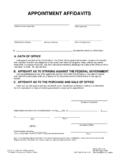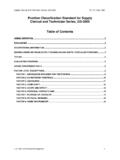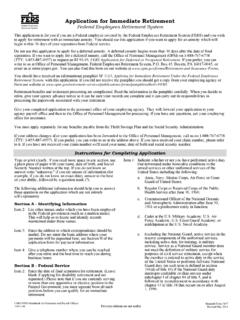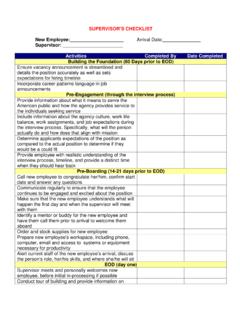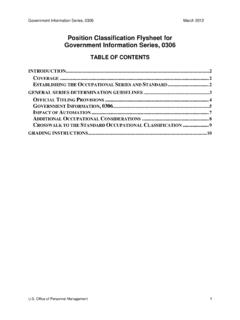Transcription of Privacy Impact Assessment (PIA) Guide - opm.gov
1 Privacy Impact Assessment (PIA) Guide This document implements the OPM. Information Security and Privacy Policy Chief Information Officer (CIO). April 2010. Privacy Impact Assessment (PIA) Guide 4/22/2010. Table of Contents 1. POLICY STATEMENT .. 1. 2. 1. 1. Scope and Applicability .. 1. Legal Authority .. 2. Maintenance of the Official 4. 3. Privacy Impact Assessment (PIA) POLICY AND PROCEDURES .. 4. When to Conduct a Privacy Threshold Analysis (PTA) .. 4. When to Conduct a Privacy Imoact Assessment (PIA) .. 5. When to Complete a System of Records Notice (SORN).. 6. When to Complete an Information Collection Request (ICR) .. 7. The PTA and PIA Process at OPM .. 7. The PTA Process .. 7. The PIA 7. 4. COMPLIANCE, ENFORCEMENT, AND 8. 5. ROLES AND RESPONSIBILITIES .. 9. APPENDIX A: HOW TO FILL OUT A Privacy THRESHOLD ANALYSIS (PTA).
2 12. APPENDIX B: HOW TO FILL OUT A Privacy Impact Assessment (PIA) .. 15. APPENDIX C: GLOSSARY .. 25. APPENDIX D: ACRONYMS .. 28. APPENDIX E: REFERENCES .. 29. i Privacy Impact Assessment (PIA) Guide 4/22/2010. REVISION HISTORY. Version Version Date Summary of Changes Number April 2005 Initial Release August 2005 Revised Draft Release December 2005 Revised Draft Release May 2006 Revised Draft Release April 2010 Document revised in its entirety EXECUTIVE SUMMARY. A Privacy Impact Assessment (PIA) is one of the most important instruments through which the Office of Personnel Management (OPM) establishes public trust in its operations. The Chief Information Officer is responsible for ensuring that technologies developed and used by the agency sustain and do not erode Privacy protections. The PIA is a vital tool that evaluates possible Privacy risks and the mitigation of those risks at the beginning of and throughout the development life cycle of a program or information technology (IT) system.
3 The transparency and analysis of Privacy issues provided by a PIA demonstrate that OPM actively engages system owners on the mitigation of potential Privacy risks. By conducting Privacy threshold analyses (PTAs) and PIAs in accordance with the policies and procedures outlined in this PIA Guide , OPM demonstrates its consideration of Privacy during the development of programs and IT systems and thus upholds the agency's commitment to maintain public trust and accountability. Without the trust of the public, the agency's mission is made more difficult. By documenting the procedures and measures through which the agency protects the Privacy of individuals, the agency can better carry out its mission. Therefore, PIAs serve several purposes: To evaluate the risk of collecting, maintaining, and disseminating information in identifiable form 1 on an OPM IT system.
4 To evaluate the Privacy and security protections on the IT system and ensure that the information is adequately protected. To ensure that information handling conforms to applicable legal, regulatory, and policy requirements throughout all stages of an IT system's development and operation. To allow the public to understand what information OPM collects and how it will be stored. 1. OMB Guidance for Implementing the Privacy Provisions of the E-Government Act of 2002, M-03-22. ii Privacy Impact Assessment (PIA) Guide 4/22/2010. To assure the public that OPM is providing services in a manner that considers the sensitivity of the personal information it receives. The version of this document that is posted to the Web is the official, authoritative version. iii Privacy Impact Assessment (PIA) Guide 4/22/2010.
5 1. POLICY STATEMENT. It is OPM policy to ensure that all information technology (IT) systems that collect, maintain, or disseminate information in an identifiable form have a Privacy Impact Assessment (PIA) or Privacy threshold analysis (PTA) conducted by the system owner in compliance with the E- Government Act of 2002, Office of Management and Budget (OMB), and National Institute of Standards and Technology (NIST) guidance. 2. INTRODUCTION. Purpose The PIA Guide is designed to help OPM protect information about individuals that will be collected, maintained, or disseminated in identifiable form to meet the requirements of the E- Government Act of 2002, and related guidance. We recommend that anyone involved in the PTA and PIA process at OPM become familiar with these laws and guidance as outlined in section below.
6 In particular, this knowledge will help program offices conduct a Privacy threshold analysis (PTA) and determine if a PIA must be completed. A PIA is an analysis of how information is handled: To ensure handling conforms to applicable legal, regulatory, and policy requirements regarding Privacy . To determine the risks and effects of collecting, maintaining, and disseminating the information in an IT system. To examine and evaluate protections and alternative processes for handling information to mitigate potential Privacy risks. Because OPM handles a large volume of information that is subject to Privacy Impact Assessments, the agency must ensure that the appropriate practices and protections are in place and applied. This has become particularly important as developments in information technology (IT) have allowed information to be quickly and easily collected, as well as allowed OPM to provide quicker and more efficient services to the public.
7 Scope and Applicability The PIA Guide and its references and appendices apply to all OPM information 2 and IT systems. OPM information includes data that is owned, sent, received, or processed by the agency and includes information in either physical or digital form. OPM IT systems include OPM hardware, software, and media. Anyone who is involved in the PTA and PIA process at OPM must know and adhere to the procedures in the PIA Guide . The PIA Guide also applies to all contractors acting on behalf of 2. The term OPM information is defined as information in either physical or digital form that is under the possession, custody, or control of OPM. 1. Privacy Impact Assessment (PIA) Guide 4/22/2010. OPM and to non-OPM organizations or their representatives who are granted authorized access to OPM IT systems.
8 The PTA and PIA Templates are available from the Privacy Program Manager. We strongly recommend that you use the step-by-step tutorial in appendix A of this document to Guide you when filling out a PTA, and the tutorial in appendix B when conducting a PIA. If you are seeking information on OPM's Privacy policies in general, please see the most recent version of the Information Security and Privacy Policy, available on the intranet at Legal Authority OPM developed the PIA Guide to comply with the laws and guidance outlined below. The E-Government Act of 2002 3. The E-Government Act requires agencies to: 1. Conduct Privacy Impact assessments (PIAs). 2. Ensure that PIAs are approved by a "reviewing official" (the agency CIO or other agency head designee, who is other than the official procuring the system or the official who conducts the PIA).
9 3. Make PIAs available to the public via a public-facing Web site. 4. Report to OMB on the completion of PIAs. Federal agencies must conduct a PIA before developing or procuring an IT system or project that collects, maintains, or disseminates information in identifiable form from or about members of the public. In addition, the E-Government Act requires that a PIA be completed before initiating, consistent with the Paperwork Reduction Act (PRA), a new electronic collection of information in identifiable form for 10 or more persons (excluding agencies or employees of the Federal Government). This guidance applies to all OPM IT systems and electronic information collections in accordance with OMB guidance for implementing Privacy provisions of the E- Government Act of 2002. The E-Government Act stipulates that each PIA must address the following seven requirements: 1.
10 What information is to be collected. 2. Why the information is being collected. 3. The intended routine use of the information. 4. With whom the information will be shared. 5. What notice or opportunities individuals have to decline to provide information. 6. How the information will be secured. 7. Whether a system of records is being created under the Privacy Act (5 552a). 3. E-Government Act is available at 2. Privacy Impact Assessment (PIA) Guide 4/22/2010. OMB Memorandum 03-22. OMB M-03-22, OMB Guidance for Implementing the Privacy Provisions of the E-Government Act of 2002, directs agencies to conduct reviews of how information about individuals is handled within their agency when they use information technology (IT) to collect new information, or when agencies develop or buy new IT systems to handle collections of personally identifiable information.


